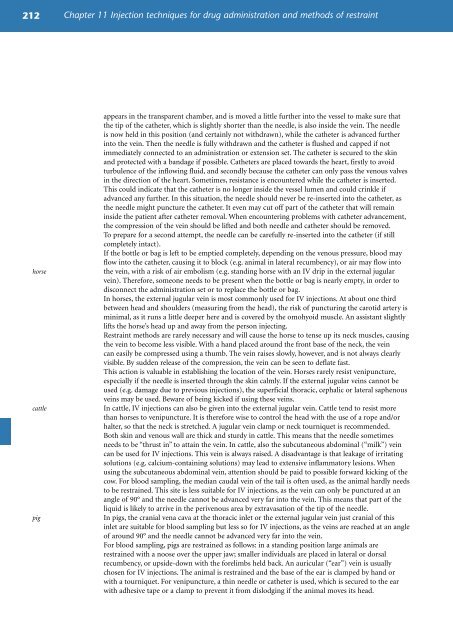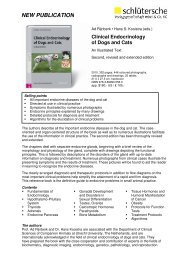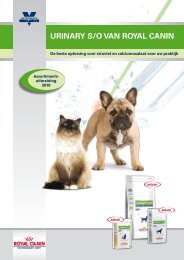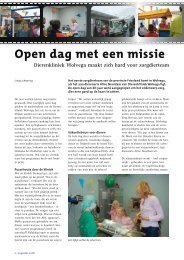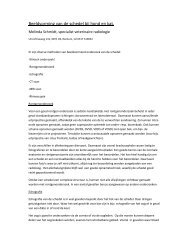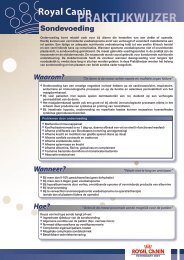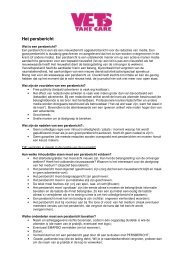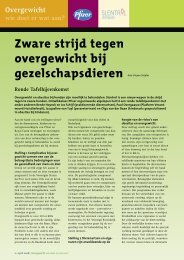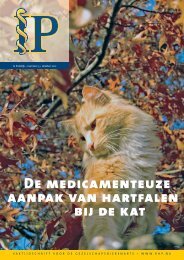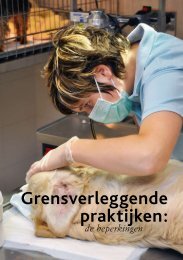Injection techniques for drug administration and methods of restraint
Injection techniques for drug administration and methods of restraint
Injection techniques for drug administration and methods of restraint
Create successful ePaper yourself
Turn your PDF publications into a flip-book with our unique Google optimized e-Paper software.
212<br />
horse<br />
cattle<br />
pig<br />
Chapter 11 <strong>Injection</strong> <strong>techniques</strong> <strong>for</strong> <strong>drug</strong> <strong>administration</strong> <strong>and</strong> <strong>methods</strong> <strong>of</strong> <strong>restraint</strong><br />
appears in the transparent chamber, <strong>and</strong> is moved a little further into the vessel to make sure that<br />
the tip <strong>of</strong> the catheter, which is slightly shorter than the needle, is also inside the vein. The needle<br />
is now held in this position (<strong>and</strong> certainly not withdrawn), while the catheter is advanced further<br />
into the vein. Then the needle is fully withdrawn <strong>and</strong> the catheter is flushed <strong>and</strong> capped if not<br />
immediately connected to an <strong>administration</strong> or extension set. The catheter is secured to the skin<br />
<strong>and</strong> protected with a b<strong>and</strong>age if possible. Catheters are placed towards the heart, firstly to avoid<br />
turbulence <strong>of</strong> the inflowing fluid, <strong>and</strong> secondly because the catheter can only pass the venous valves<br />
in the direction <strong>of</strong> the heart. Sometimes, resistance is encountered while the catheter is inserted.<br />
This could indicate that the catheter is no longer inside the vessel lumen <strong>and</strong> could crinkle if<br />
advanced any further. In this situation, the needle should never be re-inserted into the catheter, as<br />
the needle might puncture the catheter. It even may cut <strong>of</strong>f part <strong>of</strong> the catheter that will remain<br />
inside the patient after catheter removal. When encountering problems with catheter advancement,<br />
the compression <strong>of</strong> the vein should be lifted <strong>and</strong> both needle <strong>and</strong> catheter should be removed.<br />
To prepare <strong>for</strong> a second attempt, the needle can be carefully re-inserted into the catheter (if still<br />
completely intact).<br />
If the bottle or bag is left to be emptied completely, depending on the venous pressure, blood may<br />
flow into the catheter, causing it to block (e.g. animal in lateral recumbency), or air may flow into<br />
the vein, with a risk <strong>of</strong> air embolism (e.g. st<strong>and</strong>ing horse with an IV drip in the external jugular<br />
vein). There<strong>for</strong>e, someone needs to be present when the bottle or bag is nearly empty, in order to<br />
disconnect the <strong>administration</strong> set or to replace the bottle or bag.<br />
In horses, the external jugular vein is most commonly used <strong>for</strong> IV injections. At about one third<br />
between head <strong>and</strong> shoulders (measuring from the head), the risk <strong>of</strong> puncturing the carotid artery is<br />
minimal, as it runs a little deeper here <strong>and</strong> is covered by the omohyoid muscle. An assistant slightly<br />
lifts the horse’s head up <strong>and</strong> away from the person injecting.<br />
Restraint <strong>methods</strong> are rarely necessary <strong>and</strong> will cause the horse to tense up its neck muscles, causing<br />
the vein to become less visible. With a h<strong>and</strong> placed around the front base <strong>of</strong> the neck, the vein<br />
can easily be compressed using a thumb. The vein raises slowly, however, <strong>and</strong> is not always clearly<br />
visible. By sudden release <strong>of</strong> the compression, the vein can be seen to deflate fast.<br />
This action is valuable in establishing the location <strong>of</strong> the vein. Horses rarely resist venipuncture,<br />
especially if the needle is inserted through the skin calmly. If the external jugular veins cannot be<br />
used (e.g. damage due to previous injections), the superficial thoracic, cephalic or lateral saphenous<br />
veins may be used. Beware <strong>of</strong> being kicked if using these veins.<br />
In cattle, IV injections can also be given into the external jugular vein. Cattle tend to resist more<br />
than horses to venipuncture. It is there<strong>for</strong>e wise to control the head with the use <strong>of</strong> a rope <strong>and</strong>/or<br />
halter, so that the neck is stretched. A jugular vein clamp or neck tourniquet is recommended.<br />
Both skin <strong>and</strong> venous wall are thick <strong>and</strong> sturdy in cattle. This means that the needle sometimes<br />
needs to be “thrust in” to attain the vein. In cattle, also the subcutaneous abdominal (“milk”) vein<br />
can be used <strong>for</strong> IV injections. This vein is always raised. A disadvantage is that leakage <strong>of</strong> irritating<br />
solutions (e.g. calcium-containing solutions) may lead to extensive inflammatory lesions. When<br />
using the subcutaneous abdominal vein, attention should be paid to possible <strong>for</strong>ward kicking <strong>of</strong> the<br />
cow. For blood sampling, the median caudal vein <strong>of</strong> the tail is <strong>of</strong>ten used, as the animal hardly needs<br />
to be restrained. This site is less suitable <strong>for</strong> IV injections, as the vein can only be punctured at an<br />
angle <strong>of</strong> 90° <strong>and</strong> the needle cannot be advanced very far into the vein. This means that part <strong>of</strong> the<br />
liquid is likely to arrive in the perivenous area by extravasation <strong>of</strong> the tip <strong>of</strong> the needle.<br />
In pigs, the cranial vena cava at the thoracic inlet or the external jugular vein just cranial <strong>of</strong> this<br />
inlet are suitable <strong>for</strong> blood sampling but less so <strong>for</strong> IV injections, as the veins are reached at an angle<br />
<strong>of</strong> around 90° <strong>and</strong> the needle cannot be advanced very far into the vein.<br />
For blood sampling, pigs are restrained as follows: in a st<strong>and</strong>ing position large animals are<br />
restrained with a noose over the upper jaw; smaller individuals are placed in lateral or dorsal<br />
recumbency, or upside-down with the <strong>for</strong>elimbs held back. An auricular (“ear”) vein is usually<br />
chosen <strong>for</strong> IV injections. The animal is restrained <strong>and</strong> the base <strong>of</strong> the ear is clamped by h<strong>and</strong> or<br />
with a tourniquet. For venipuncture, a thin needle or catheter is used, which is secured to the ear<br />
with adhesive tape or a clamp to prevent it from dislodging if the animal moves its head.


